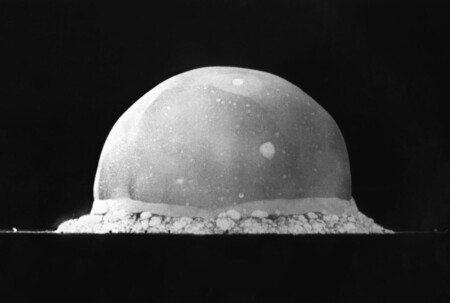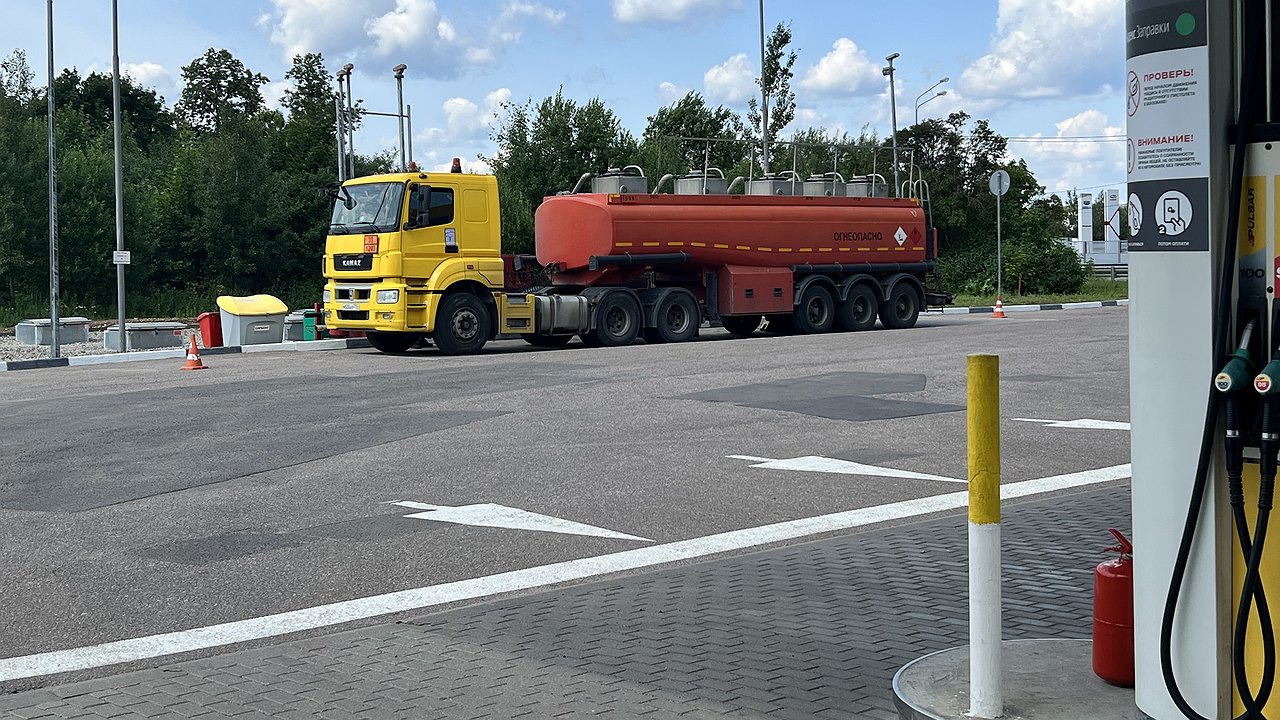A few decades ago, if you took a walk in the fields of Alamogordo in the state of New Mexico, you could find strange grayish-green lumpy pebbles on the ground, small, a few grams and barely a centimeter thick. But the most curious thing was not its shape, weight or glassy appearance. It didn’t even have a hue, in some cases with reddish speckles. If there’s anything special about them, it’s that they’re relics, not regular minerals. And not of any kind. These stones were remnants of earth that melted during the Trinity test in 1945 and are now reminiscent of the movie ‘Oppenheimer’.
The name speaks for itself: these pieces are known as trinite, atomsite, or directly “Alamogordo glass.” And yes, they are radioactive, although not dangerous, according to ORAU technicians. Despite this, towards the 1950s authorities excavated and they buried all the trinititas what they found in the area so that no one could dig it up under strict prohibition.
Nearly eighty years after the gadget’s atomic explosion in the desert—in capital letters like this one—on Day of the Dead, the trinitite story is a simple curiosity, probably so small it’s a footnote in the history of the Manhattan Project. Even today what remains is highly symbolic. First, because it helps understand the impact of atomic testing in the mid-40s on parts of the state of New Mexico. Secondly, for how they sneaked into the lives of those who lived in areas exposed to radiation at that time, or who still live today.
Trinity’s Long Shadow
“My uncle tells me how my grandmother took them on a picnic to the Trinity District. They all took it. I heard from many sources that people go there and fill their pockets with ‘that green crystal’ and take them home. It was a unique thing, what did you play with“, says Tina Cordova, the daughter of a resident who died after suffering from three cancers and who even today, in 2023, co-founded the Tularosa Basin Downwinders Consortium (TBDC), a group that seeks medical attention and compensation for New Mexicans affected by the Trinity test.
To understand its claims and the footprint of nuclear tests in the region, it is necessary to recall what happened in the early morning of July 16, 1945, when the gadget was launched in the desert of Jornada del Muerto. That and its content, of course.
Tularosa Basin in New Mexico, secret place, It’s relatively close to Los Alamos National Laboratory and has an arid environment shaken by more or less predictable winds, so it’s no surprise that the leaders of the Manhattan Project had their eyes set on that region of the south of the country when they needed to look for a site for nuclear tests.
There, in the deserted desert of the Day of the Dead, the Gadget bomb exploded at 5:29 am on July 16, 1945; this episode has been resurrected almost 80 years later thanks to Nolan’s movie. Well-filled with 13 pounds of plutonium, the device, as will be seen, was dropped, in excess of what was required, from a 100-foot tower and within seconds wrote one of the most important chapters of the 20th century, or indeed of all human history: the first explosion of an atomic bomb.
Or the same, the starting signal for the tense nuclear age.
The explosion was brutal.
Wild.
It can be seen from miles away.
Much more than desirable for a secret project.
Gadget is the codename for the nuclear device.
Witnesses claimed to have seen a bright light as far away as Albuquerque, more than 200 kilometers away. It’s hard to make more “noise”. The problem is, if Trinity’s success mattered, equally important Turns out he kept it a secret. The US authorities contented themselves with giving a note to the papers, which they attributed to the accidental explosion of ammunition and fireworks, and refused an evacuation that could cause panic in the region or worse, draw attention to the project.
The Atomic Heritage Foundation (AHF) remembers how soldiers were dispersed to surrounding towns when they needed to be evacuated, and General Leslie Groves even contacted the governor of New Mexico to warn him that martial law might be required in the town of Amarillo, about 70,000 people, just 480 kilometers away.
The truth is that no matter how far the chosen place is, explosionIt was not a barren land. There were people sitting relatively close. The U.S. National Park Service (NPS) recalls the existence of farmers living just 13 miles (21 km) from the test site and “tens of thousands” of farmers within a 50-mile (80.5-km) radius. They didn’t officially learn what had happened until after the bombings of Hiroshima and Nagasaki.
Similar calculations are provided by those affected by the test. downwindersPeople living at a distance of less than 20 kilometers and guaranteeing that there are “tens of thousands” in a radius that does not reach 90 km. In 2021, one of these reluctant witnesses, Barbara Kent, then a 13-year-old girl, told the Nuclear Threat Initiative (NTI) how she experienced the explosion.
Exacerbation of the Trinity test.
HE July 16, 1945 He was resting with a dozen youths at a camp in Ruidoso when the explosion knocked him out of bed. When they parted soon after, they were met with a surprise as surreal as it was inexplicable: flakes were falling from the sky! Or at least it seemed so. “We all said, ‘Oh my God,’ it’s July and it’s snowing… But it was so hot. We took it in our hands and rubbed it on our face.” Over the years he learned that it was radioactive fallout.
In the NPS article, a US federal agency, “Because the test was conducted relatively close to the ground, it released large amounts of radiation into the atmosphere. The radioactive fallout descended to the northeast in an area about 250 miles long and 200 miles wide. The scientists traced some of the radioactive fallout pattern to the Atlantic.
Its author, Jade Ryerson, says that in New Mexico, radiation has polluted the water supply that many residents drink from cisterns or storage tanks placed directly on the deck of their homes, and affected vegetables and livestock. The scientists themselves purchased some of the burned cattle to study the effect of radiation.
What was his real reach? What effect did it have?
“This is difficult, if not impossible, to measure,” explains the AHF. What is undeniable is that there were people who lived or lived in the counties that eventually came to be known as Lincoln, Otero, Socorro, and Sierra. downwinders and they claim to have suffered the consequences of radiation in the 1940s; this is a long toxic legacy that translates into higher rates of cancer and other diseases and a clear decline in their quality of life.
For them, the movie ‘Oppenheimer’ was a unique opportunity to put their claim into action… almost 80 years after the Trinity test.
“Very little was done back then assessing health More than 70 years have passed since the inhabitants of central New Mexico and Trinity. However, it is almost certain that residents are exposed to dangerously high levels of radiation. Radioactive fallout fell on plants and animals that would be consumed by the local population”, AHF is plentiful.
The TBDC collective continues to highlight the seriousness of the problem. According to their research, the tests caused cancer in “most of the 30,000 people living in the area.” “Ash fell for days. To understand the impact on the population, you have to understand how people lived in rural New Mexico in 1945.”
“[El Gobierno] “I knew it wasn’t safe for people to live 13 miles away, but people kept doing what they always did, and partly because they didn’t understand what it meant to be exposed to radiation.” people take root to the ground too. The Tularosa church is 150 years old.”
The Washington-based NTI claims that the infant mortality rate in New Mexico was 56% higher in 1945 than in previous years, and that cancer incidence among adults began to increase in the years after Trinity.
“The situation is complex due to economic and social factors. Access to medical care is difficult, often challenging. downwinders driving hours to the nearest hospital. The AHF adds that a 2017 survey showed that Lincoln, Socorro, Otero and Sierra are facing economic challenges, with median household incomes falling below the state and national medians. Many had to dive into already tight savings accounts to pay for their treatment. Some have lost their jobs, while others suffer from pre-existing ailments that limit their job opportunities.”
those in the Tularosa Basin in New Mexico, they are not the only ones downwinders Claiming to have experienced a similar situation, US officials passed a Radiation Exposure Compensation Act (RECA) in 1990 that provided $50,000 to $100,000 to those exposed to radiation during uranium mining or government atomic testing in Nevada in the 1950s. RECA funds are designed to make it easier to pay for your treatments.
They claim to have access to the same help in New Mexico.
This downwinders They continue to push to take advantage of RECA. “Initially we wanted the government to come back, apologize to the public, and acknowledge that we were entering the service of the country without our knowledge or consent. But then we learned that in 1990 there was a fund called RECA. downwinders Nevada is displaced and devastated. We’re down to zero, counting as zero in this equation,” Cordova told the publication. New York Architectural League. They have until 2024 to get this valuable recognition.
Now his story and assertion is gaining prominence again with the Christopher Nolan movie. “They will never think that New Mexicans gave their lives. the dirtiest jobs. They invaded our lives and left,” the founder of TBDC had claimed recently. Los Angeles times.
The long shadow of that huge ball of fire that rose 78 years ago.
Images: Terry Robinson (Flickr), Thad Zajdowicz (Flickr), Los Alamos National Laboratory, Berlin Brixner/Los Alamos National Laboratory
On Xataka: When Apollo 11 astronauts spent three weeks in a NASA bunker for fear of “moon bugs”



















